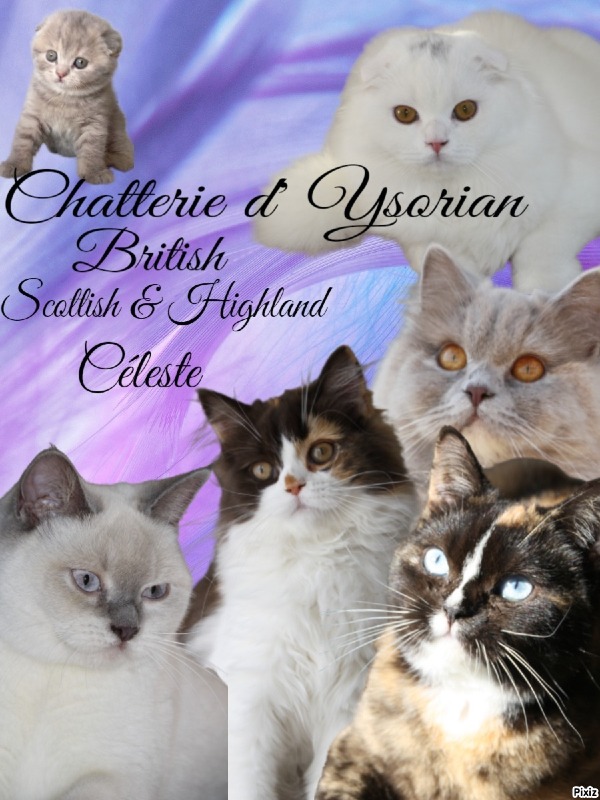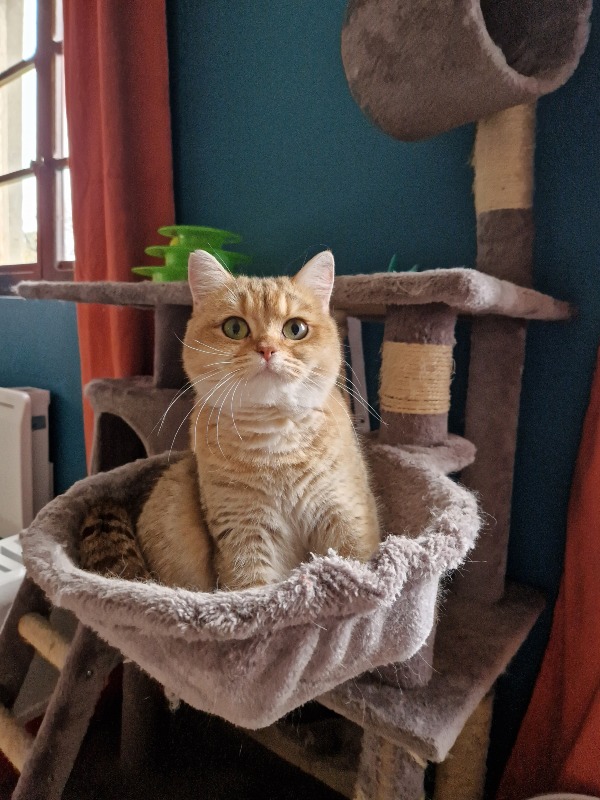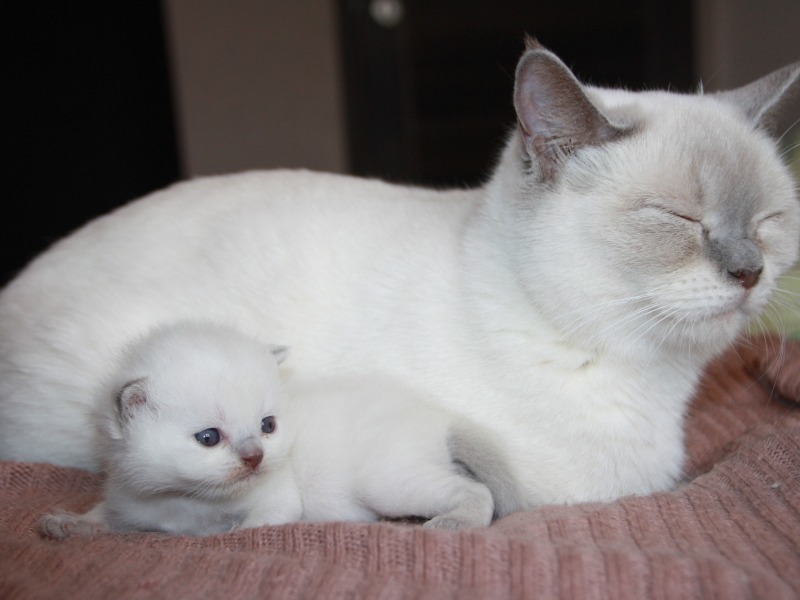British shorthair
Autres noms : Short hair cats, British short hair cats, British cats
Discover the British Shorthair, a cat breed known for its gentle temperament and robust appearance. With its dense coat and large round eyes, it is both adorable and affectionate. Ideal for families, this loyal companion combines calmness and intelligence for a harmonious coexistence.
Awareness of acquiring an animal
Adoption and breeding of cats should always be guided by a sincere attachment to the animal and an understanding of its specific needs. Whether for leisure or passion, it is essential to provide a safe, enriching, and suitable environment. Avoid any impulsive acquisition that could harm their well-being. Cats require attention, regular healthcare, and a secure space. Commit to providing them with a quality life by being a conscientious and informed owner or breeder.
To learn more about animal welfare, we invite you to consult our FAQ by clicking the button below:
Origins and history
The British Shorthair has its origins in the ancient guard cats that lived in Great Britain. During antiquity, these felines were prized for their robustness and ability to hunt pests. Their muscular physique and dense coat allowed them to adapt well to the harsh climates of the island. Over the centuries, they naturally hybridized with other breeds, but remained largely isolated.
In the 19th century, the appeal of these cats led to the formalization of their breeding. The first cat show in 1871 in London marked a significant turning point. On this occasion, the British Shorthair was highlighted and quickly gained popularity. Breeders worked to establish the breed standards, emphasizing its distinctive physical characteristics, such as its stocky body, round cheeks, and thick coat.
Throughout the 20th century, global conflicts weakened the breed, leading to a decline in their population. Nevertheless, conservation efforts emerged after World War II, allowing for the revival of the British Shorthair. Today, this breed is one of the most cherished for its balanced personality and charming appearance, combining both gentleness and independence.
Physical characteristics
The British Shorthair is a highly sought-after breed, recognized for its distinctive and charismatic appearance. Its physical characteristics are particularly marked by a robust and muscular structure. The body is broad and well-proportioned, conveying an impression of strength and solidity. The legs are short and powerful, ending in round paws, which enhances its imposing look.
The head of the British Shorthair is distinguished by its round and wide shape, with a flat forehead and well-developed cheeks. Its eyes are also round, large, and brilliantly colored, ranging from copper to gold, giving it a look that is both affectionate and expressive. The ears, medium to large in size, are slightly rounded at the tips and are positioned widely apart on the top of the head.
In terms of coat, this breed possesses a very dense and short fur, offering a soft texture to the touch. The fur often displays visible grooves, adding depth to its coat. The various colors and patterns, ranging from solid shades to stripes and spots, enhance the aesthetic appeal of this breed, contributing to its visual charm.
Character
The British Shorthair is known for its robust appearance and balanced temperament. This cat exudes an aura of calmness and serenity. It is generally very affectionate, enjoying the company of its owners without being overly clingy. Its gentle nature allows it to easily adapt to different environments, whether it's a bustling household or a quieter home.
Intelligence is another striking trait of this breed. British Shorthairs are curious and capable of engaging in intelligent games, which makes them stimulating companions for their owners. Their independence is also notable, allowing them to spend some time alone without becoming anxious or destructive.
When it comes to sociability, these cats are quite friendly. They usually get along well with children and other pets. This sociable temperament does not mean they are overly intrusive; on the contrary, they know how to respect others' space and prefer to approach interactions at their own pace. In summary, the British Shorthair combines sweetness, intelligence, and independence, making it an ideal companion.
Life expectancy
The life expectancy of British Shorthair cats generally ranges from 12 to 20 years. Several factors influence this lifespan, including genetics, diet, veterinary care, and the cat's lifestyle. A better understanding of these elements can help maximize their longevity.
Genetics plays a crucial role in a cat's overall health. British Shorthairs may be predisposed to certain hereditary diseases, such as hypertrophic cardiomyopathy, a common heart condition in this breed. Therefore, it is essential to choose a responsible breeder who performs health tests on their breeding animals to minimize these risks.
Diet is another key factor. A balanced diet rich in nutrients can contribute to better overall health. Owners should ensure they provide an appropriate diet that is suited to the age and activity level of the cat. Regular visits to the veterinarian, including vaccinations and health check-ups, are also crucial for detecting potential issues early on.
Finally, lifestyle has a significant impact on life expectancy. Indoor cats tend to live longer than those with outdoor access, due to reduced exposure to dangers such as accidents or contagious diseases. By taking care of these various aspects, owners can help ensure a long and healthy life for their companions.
Exercise and activity needs
British Shorthairs are generally known for their calm temperament and affectionate nature. However, they have specific exercise and activity needs that must be considered to ensure their well-being. Although they are not the most active cats, they require sufficient physical and mental stimulation to avoid boredom and health issues.
A daily exercise routine is essential to maintain their healthy weight and promote good physical condition. This can include interactive play sessions with feather toys, lasers, or balls that encourage hunting behavior. British Shorthairs typically enjoy engaging in activities that mimic their natural hunting instincts.
Additionally, mental stimulation is equally important. Puzzle toys and brain games can help prevent boredom and stimulate their minds. Creating an enriching environment with multiple levels for exploration, such as cat trees and scratching posts, can also encourage activity. By integrating these elements into their daily lives, we promote a healthy and fulfilling lifestyle for this breed.
Recommended diet
The British Shorthair cat breed requires a balanced diet tailored to its specific needs. Due to their robust morphology and tendency to gain weight, it is essential to monitor their diet closely. British Shorthairs need high-quality protein-rich food sourced from animal ingredients, which is crucial for maintaining their muscle mass.
Healthy fats should also be part of their diet. Omega-3 and omega-6 fatty acids, found in foods like fish, contribute to skin and coat health. Avoid foods high in carbohydrates, as these can promote weight gain. Opt for kibble specifically designed for purebred cats, which takes their metabolism into account.
It is recommended to divide meals into small portions throughout the day to prevent the cat from eating too quickly. Access to fresh, clean water should be constant. If in doubt, consult a veterinarian to establish a customized diet considering your cat's age, weight, and activity level.
Training and obedience
The education and training of British Shorthair cats require a gentle and patient approach, as these felines are known for their calm temperament and independent nature. It is essential to start training at a young age, when kittens are more receptive to new experiences. Using positive reinforcement techniques, such as treats and praise, fosters a strong bond between the owner and the animal.
British Shorthairs are generally quite intelligent, capable of learning simple tricks and adapting to routines. It is advisable to provide them with stimulating toys to prevent boredom and encourage their cognitive development. Regular interaction and play are crucial for channeling their energy, which also helps to prevent destructive behaviors.
Socialization is another fundamental aspect of their education. Exposing these cats to different people, animals, and environments from a young age prepares them to be well-balanced adults. Finally, it is recommended to maintain a regular routine regarding feeding, play, and care to ensure optimal well-being throughout their lives.
Behavior with children
The British Shorthair is known for its calm and affectionate temperament, making it an ideal companion for children. This breed is distinguished by its sociable and friendly nature, which promotes good interaction with younger ones. Their laid-back character creates a serene environment, which is essential when living with energetic children.
These cats are generally patient and tolerant, meaning they can withstand the occasional rough cuddles or energetic play from children. They quickly learn to recognize boundaries, providing a reassuring interaction. However, it is essential to teach children how to interact properly with animals, highlighting the importance of respecting their space and needs.
The curiosity of British Shorthairs also makes them inclined to participate in family activities. Whether it's playing, exploring, or simply curling up on the couch, these cats easily integrate into the daily lives of families. In conclusion, this breed can provide a rewarding and joyful experience for children, as long as the interactions are supervised.
Compatibility with Other Animals
The British Shorthair is a cat breed known for its companionable character and gentle nature. Generally, this breed tends to be quite compatible with other domestic animals, including dogs and other cats. Their calm temperament often allows for easy adaptation to a shared environment. This is especially true if introductions are made gradually and in a controlled setting.
When a British Shorthair is socialized from a young age, it develops friendly behaviors towards other animals. Positive interactions, such as play or moments of relaxation, encourage harmonious relationships. However, it remains essential to monitor initial meetings to ensure that neither the cat nor the other animal experiences stress.
On the other hand, it is crucial to consider the individual personality of each animal. Some dogs may have a stronger hunting instinct, making cohabitation difficult. Therefore, the owners' vigilance is vital to prevent conflicts. A gradual introduction and the use of treats can promote peaceful and enriching relationships within the household.
Grooming needs
The British Shorthair is a breed of cat with a dense and short coat, which makes maintenance easier compared to other long-haired breeds. However, regular grooming is still beneficial for keeping its fur and skin healthy. Weekly brushing helps remove dead hair and prevent the accumulation of hairballs, while also stimulating blood circulation through the massage of the skin.
Regarding claw care, it is important to trim them regularly to prevent them from getting caught or breaking, and to stop destructive behaviors. The ears and eyes should also be checked regularly, although this breed is generally not prone to eye or ear problems.
Finally, special attention should be given to the diet and weight of the British Shorthair, as this breed tends to gain weight easily. A balanced diet, combined with daily exercise, helps maintain overall good health. In summary, even though maintenance is relatively simple, regular grooming and preventive care contribute to the well-being of this cat.
Health
The health of British Shorthairs is an important topic for any prospective owner. These cats, known for their robust appearance and calm temperament, are not without vulnerabilities. One of the main health concerns is hypertrophic cardiomyopathy, a common heart disease in this breed. This condition can develop without apparent symptoms, so it is crucial to have regular veterinary check-ups to ensure proper monitoring.
Moreover, genetics play a significant role in the health of this breed. British Shorthairs are prone to joint issues, particularly hip dysplasia. This can lead to pain and mobility difficulties, sometimes requiring surgical intervention. Careful monitoring of their weight is also essential, as obesity can exacerbate these joint problems and lead to other health complications.
Prevention is key for these cats. A balanced diet tailored to their energy needs, along with regular exercise, will help reduce the risk of diseases. Finally, early socialization and regular veterinary visits are vital for maintaining their overall well-being. By taking care of these aspects, owners can provide a healthy and fulfilling life for their four-legged companion.
Environment and habitat
The British Shorthair is a cat with a soothing temperament, easily adapting to various environments. This breed is particularly comfortable in domestic habitats, where it can enjoy quiet spaces for resting and hiding. A home with cozy areas, such as cushions and warm spots, is ideal for this feline.
In terms of activity, the British Shorthair prefers moderate movements. A habitat equipped with interactive toys and climbing spaces can stimulate its playful instincts without exhausting it. With a calm and reserved temperament, it enjoys playtime but also appreciates peace and quiet.
This breed handles changes well, but a stable environment is ideal for its well-being. The importance of a secure space should not be underestimated, as a British Shorthair feels more comfortable when it can explore safely. In summary, a calm, comfortable, and stimulating home is the perfect environment for this breed known for its gentleness and independence.
Name ideas
Choosing a name for a British Shorthair cat may seem like a fun task, but it's an important decision that can reflect the animal's personality, appearance, or even your own preferences. A good name should be short, easy to pronounce, and memorable. Consider distinctive physical characteristics, such as thick fur and round eyes, or personality traits often associated with this breed, such as gentleness and affection.
It can also be helpful to think about cultural references, place names, or even names that evoke a certain elegance, which is fitting for a British Shorthair. Consider the sound of the name, which should be pleasant to the ear and easy to call out. Avoid names that are too long, as they may confuse your pet.
Here are some name suggestions for a British Shorthair cat:
Milo, Bella, Oliver, Chloe, Winston, Daisy, Max, Emerald, Sapphire, Cherry, Oscar, Light, Hugo, Cherry, Theseus.
These names encompass both the personality and appearance of British Shorthairs while remaining trendy and charming.
Average purchase price
The prices of British Shorthair cats vary significantly based on several factors. Generally, the cost of a kitten ranges from 800 to 2,000 euros. This wide range reflects elements such as the quality of the breeding, the parents, and the lineage. Animals from champion lines may have higher prices, as they are often considered high-quality specimens.
Another factor influencing the price is the geographical location of the breeder. In certain areas, costs can be higher due to increased demand or limited availability. Additionally, reputable breeders who adhere to strict standards for animal health and welfare may charge more to ensure ethical breeding practices.
Finally, it is important to note that the acquisition cost is only part of the financial commitment. Veterinary care, quality food, and necessary supplies for such an animal are also considerations to include in the total budget.
Expenses
Owning a British Shorthair cat involves a certain monthly budget. On average, it is advisable to plan for around 60 to 100 euros per month to cover essential expenses, although this amount can vary based on product and service choices.
Food expenses represent a significant portion of the budget. A good diet can cost between 30 and 50 euros per month. It is essential to choose high-quality kibble that meets the nutritional needs of this breed, which can affect the cost.
Veterinary care should also be taken into account. Depending on annual visits and vaccinations, it is wise to budget around 10 to 20 euros per month on average to spread out the costs. Additionally, it may be necessary to include extra expenses for preventive treatments, such as deworming or parasite control.
Finally, don't forget the expenses related to accessories and hygiene, such as litter, toys, and scratching posts. This can add approximately 10 to 30 euros more per month, depending on the cat's preferences and the products chosen. In summary, the monthly budget for a British Shorthair typically ranges between 60 and 100 euros, always ensuring the quality of care provided to your pet.
Destination and usage
The British Shorthair is a breed of cat particularly prized as a pet. Its calm and affectionate personality makes it an ideal companion for families, single individuals, and children. Their balanced temperament allows for harmonious coexistence with other pets, making them perfect for multi-species households.
One of the notable characteristics of this cat is its sociability. British Shorthairs enjoy being in the company of their humans while also being independent. They often appreciate playtime without being overly demanding in terms of attention. Families can benefit from their gentle and forgiving nature, making them suitable for dynamic and sometimes loud environments.
In addition to being excellent pets at home, they prove to be pleasant travel companions during car trips or stays with friends. Their adaptable nature makes traveling easier, making this breed ideal for those who seek a loyal companion on their adventures. Overall, the British Shorthair combines charm, sweetness, and a touch of elegance, making it a favored choice for those looking for a stable and loving feline companion.
Legislation and regulation
Legislation regarding pets varies significantly from country to country, including for British Shorthair cats. In many countries, there are no specific regulations concerning this breed, but general animal welfare laws apply. These laws aim to ensure adequate living conditions, access to veterinary care, and ethical breeding practices.
In Europe, feline organizations impose standards for breeding and welfare, encouraging breeders to adhere to strict norms to ensure the health of the animals. Responsible breeding methods are often recommended to avoid genetic issues. Additionally, some regulations prohibit excessive inbreeding to protect genetic diversity.
In North America, local laws may influence breeders and owners, but there is no federal regulation dedicated specifically to this breed. Shelters and animal protection organizations often work to raise public awareness about responsible adoption and spaying/neutering.
In Asia, the popularity of this breed has led some countries to develop breeding regulations, although the enforcement of laws may vary. Countries where the industrialization of breeding is booming are beginning to establish quality standards to improve the welfare of felines.
Ultimately, legislation concerning British Shorthairs focuses more on general animal welfare principles, without prevalent specifics. It is essential for breeders and owners to stay informed about local laws to ensure ethical and respectful treatment of these animals.
Official recognition
The official recognition of British Shorthair cats varies from country to country. In many countries, this breed is widely accepted and bred. For example, in Europe, organizations like the International Cat Fancy Federation and the Cat Fanciers' Association have recognized this breed for decades, contributing to its growing popularity.
In North America, the recognition of British Shorthairs has been slower. Although they are increasingly present at cat shows, their official status has been established relatively recently. Breed standards are strictly defined, ensuring a certain homogeneity in physical and behavioral traits.
In other regions, such as Asia, the situation is constantly evolving. Many Asian countries are beginning to celebrate the diversity of cat breeds, and British Shorthairs are gaining popularity. Breeders are working to increase their visibility through shows and competitions.
In summary, the official recognition of the British Shorthair breed is a dynamic phenomenon influenced by cultural trends and the efforts of breeders, varying across continents and nations.
Pedigrees
To obtain a pedigree for a British Shorthair cat, it is essential to contact recognized organizations in the field of cat breeding. Among the most prestigious is the International Cat Federation (FIFe), which establishes strict standards for the breeding and registration of purebred cats. Breeders who adhere to this federation must comply with high criteria regarding reproduction, health, and animal welfare.
Another well-known organization is the Cat Fanciers' Association (CFA), which is highly influential, especially in North America. It also offers registration procedures for pedigrees, ensuring traceability of lineages and adherence to breed standards.
In Europe, the World Cat Federation (WCF) is also a major player, providing registration services for breeders and ensuring that cats comply with the specific breed standards. Each organization has its own requirements regarding health testing and the documentation necessary for registration.
To ensure the quality and authenticity of the pedigree, it is recommended to choose a breeder who is a member of one of these organizations. This not only guarantees compliance with breed standards but also a commitment to animal welfare. Additionally, local or national clubs specializing in British Shorthairs can also provide valuable assistance and advice to owners interested in acquiring or breeding this breed.
Prohibitions
The bans regarding cat breeds can vary significantly from one country to another, and the British Shorthair breed is no exception. In most countries, this breed is recognized and widely accepted. However, some countries impose strict regulations on the importation and ownership of pets, which may affect this breed.
In certain regions, concerns related to transmissible diseases or animal welfare standards may prompt governments to prohibit or restrict the importation of certain breeds. For example, health certificates and appropriate vaccinations may be required before these animals can enter the country. This can deter potential owners or breeders from proceeding with importation.
Furthermore, in contexts where animal shelters play a significant role, initiatives may be implemented to encourage adoption rather than the purchase of specific breeds, which could indirectly affect the popularity or legitimacy of certain breeds. Consequently, while the British Shorthair is generally popular, legal and ethical considerations may influence its status in various countries.
Breeders of British shorthair
Want to see more breeders of British shorthair?
Check out the page of our directory listing all breeders of British shorthairClassified Ads of British shorthair
Want to see more ads of British shorthair?
Check out the page listing all the ads of British shorthairBreed clubs of british shorthair
No of british shorthair breed clubs are currently registered on Preeders.
If you would like to highlight your breed club, sign up for free now and be the first to appear on this page.







